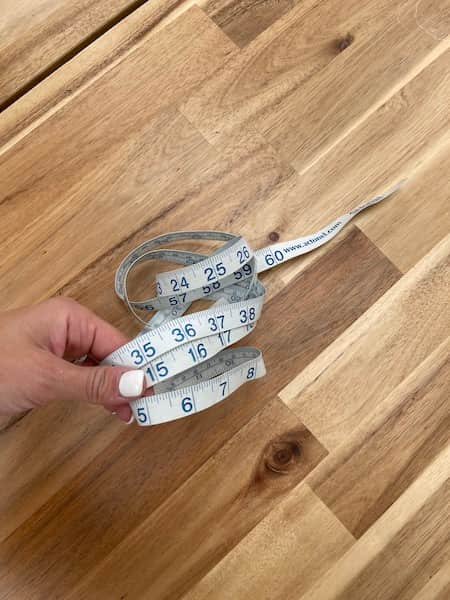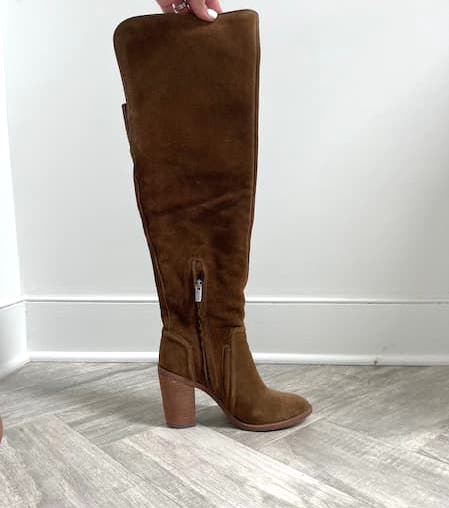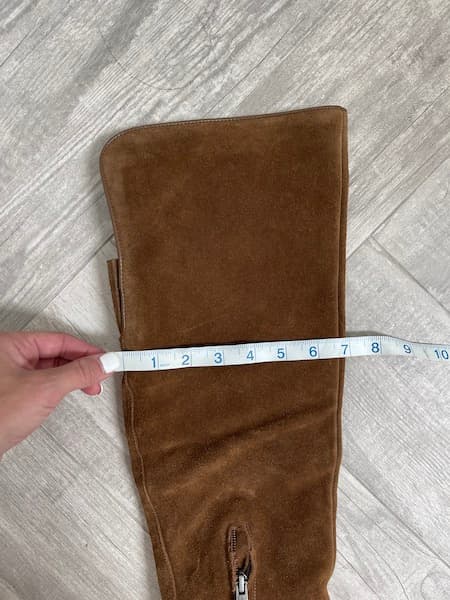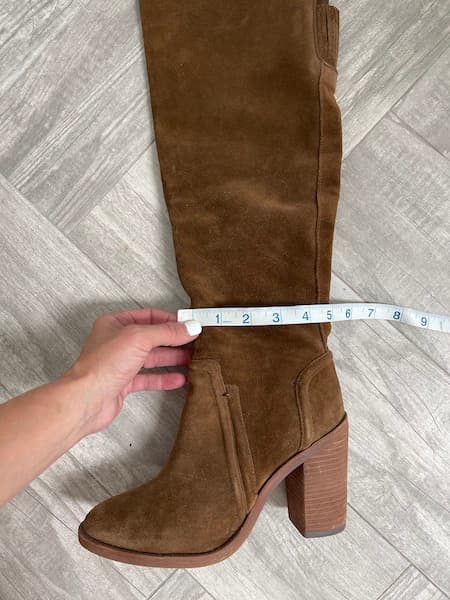What Is The Boot Shaft? Plus How To Best Measure It
If you’re shopping for boots, you’ve more than likely seen the term “boot shaft” more than once.
But what is a shoe shaft (or boot shaft), and why is it important?
The boot shaft is the part of the boot that covers your lower legs, from the ankle to the knee or higher.
It can be made of various materials, such as leather, suede, or synthetic materials, and can have different features like zippers, buckles, or laces.
Knowing how to measure the boot shaft is also very important when shopping for boots.
If the shaft is too short, the boots may not cover your legs properly, whereas a shaft that’s too tall can be uncomfortable or even painful to wear.
More importantly, however, is making sure that the shaft in any particular pair of boots is not too loose or too tight.
This is especially important if you have wider or narrower calves, as you want to ensure a comfortable fit.

Why Is The Boot Shaft Important?
The shaft of a boot is important because it can have a huge impact on how the boot fits and feels.
The shaft of the boot can come in a variety of heights and styles, from ankle boots to tactical boots, cowboy boots, and even taller boots like knee-high boots.
In addition, boots can have a straight shaft or a curved or slanted shaft.
The shaft can also be decorated with stitching, embroidery, or other embellishments or small objects such as what you would see on a traditional cowboy boot.
The purpose of the shaft of your boot is to give support and extra protection to your foot and lower leg.
It can also help to keep your foot in place without slipping around.
The shaft also helps to protect boot wearers calves from scratches, cuts, and other injuries that can occur.
When it comes to choosing the right boot, there are a few things to consider.
First, think about the height of the shaft.
If you have short legs, a tall boot shaft may make your legs look even shorter.
On the other hand, if you have long legs, a short boot shaft may not provide enough support.
You should also consider the shape of the shaft.
A straight shaft may be more comfortable for some people, while others may prefer a curved or slanted shaft depending on their calf size.
The type of material used for the shaft can also affect how the boot fits and feels.
Leather is a popular choice for boot shafts because it’s durable and molds to your foot over time.
Overall, the boot shaft is a very important component of any boot, and choosing the right one can make or break how comfortable and supportive your boots are.

Why Is It Important To Measure The Boot Shaft?
When it comes to buying new boots, you definitely want to search for the right size by measuring the boot shaft to make sure the boot fits well and is comfortable.
If the boot shaft is too short or too tight, it can cause a lot of discomfort and pain by rubbing against your skin and potentially causing blisters.
On the other hand, if the boot shaft is too tall, it can restrict your movement and make it difficult to walk.
Taking the boot shaft height into consideration is also important for finding the right style of boots.
Different boot shaft heights are best for different occasions and outfits.
For example, ankle boots are perfect for casual wear, while knee-high boots are ideal for formal occasions.
In some cases, the shaft of the boot is for functional and protection purposes such as with a work boot height.
How to Measure A Boot Shaft
Here are the steps to get an accurate measurement of the boot shaft:

1. Get a flexible tape measure
You need a flexible tape measure to measure the boot shaft accurately.
A rigid ruler likely won’t work accurately for measuring the shaft’s curve, so it is best to use a tape measure.

2. Place the boot on a flat surface
Put the boot on a flat surface to ensure that it is stable and completely upright.
This positioning will help you measure the shaft’s height and circumference accurately.

3. Measure the shaft height
To measure the boot shaft’s height, place one end of the tape measure at the top of the arch where the shaft meets the boot’s sole.
Extend the measuring tape from the sole of the boot to the top of the boot. This measurement is the boot’s shaft height.

4. Measure the shaft circumference
To measure the boot shaft’s calf circumference, wrap the tape measure around the widest point of the boot shaft.
This measurement will help you determine if the boot will fit your calf comfortably.

For taller boots, it can be helpful to know the ankle circumference as well.
Measure the same way but at the ankle as opposed to the widest part of the boot.
5. Record your measurements
If you have several pairs of boots, keep a log of each one and their shaft heights for future reference.
Different Boot Styles and Their Shaft Heights
When it comes to boots, there are so many different styles to choose from.
Each style has its own unique look and purpose, and the height of the shaft can vary greatly between styles with both functional and stylish purposes.
Here are some of the most common boot styles and their typical shaft heights:

Work boots
Work boots are designed for durability and protection in tough work environments.
They typically have a mid-calf shaft height, which offers coverage and support for the ankle and lower leg.
Popular work boot brands like Timberland and Thorogood offer a variety of styles with mid-calf shaft heights.

Ankle Boots
These types of boots are very common and have a shorter shaft reaching just to or above the ankle bone.
They are the perfect boot to dress up or down.

Mid-calf boots
Mid-calf boots are incredibly versatile and can be dressed up or down.
They typically have a shaft height that falls between the ankle and the knee, making them a great option for both casual and formal occasions.
Mid-calf boots come in a variety of materials, including leather, suede, and synthetic materials.
They can also have a varying heel height perfect for different occasions as well.

Knee-high boots
Knee-high boots are a classic closet staple that is extremely versatile, which is why they’ve never gone out of style (and probably never will).
They have a taller shaft that reaches just below the knee, providing enough coverage and support for the lower leg.
Knee-high boots come in a variety of styles, including riding boots, combat boots, and more.

Over-the-knee boots
Over-the-knee boots are a much more bold and daring style that can add a touch of personality to any outfit.
They typically have a shaft height that reaches above the knee, sometimes even up to the thigh.
Over-the-knee boots also come in different materials, including leather, suede, and stretchy fabrics and most often have tall heels.

Tall boots
This is a more general term that can refer to a versatile boot style that can be worn in a variety of settings.
They typically have a shaft height that reaches just below the knee, making them a great option for both casual and formal occasions.
Tall boots are typically more of a dress shoe than shorter mid-calf or ankle boots.
FAQs
What is the ideal boot shaft height?
The ideal boot shaft height is completely dependent on your personal preference and the type of boots you are looking for.
For example, ankle boots have a shorter shaft, while knee-high boots have a longer shaft.
You should consider your body type, style, and the occasion you will be wearing the boots for.
How do I measure the opening of a boot shaft?
To measure the opening of a boot shaft, use a flexible measuring tape and wrap it around the widest part of the shaft.
Make sure to measure the circumference of the shaft, not the width – this is the same as the calf circumference.
This measurement will give you an idea of how wide the opening of the boot is and whether it will fit comfortably around your calf.
What is the standard width for a boot shaft?
There is no standard width for a boot shaft, as it varies depending on the style of the boot.
Some boots have a narrow shaft, while others have a wider shaft to accommodate thicker socks or wider calves.
It’s important to check the product description and reviews or, even better, to try on the boots to make sure they’re a comfortable fit.
How can I keep my boots from slouching?
For boots with taller shafts you might consider using boot shaft shapers to help them keep their shape when you’re not wearing them.
A boot shaper simply slides into the boot to keep it upright and can even help to prolong the life of your boots!
How does the style of a boot shaft affect fit?
The style of a boot shaft can affect fit in several ways.
For example, a slouchy boot shaft may fit more loosely around the ankle and calf, while a fitted boot shaft will hug your leg more closely.
You’ll definitely want to consider the style of the boot shaft when choosing boots to make sure they are both flattering and well fitted.





